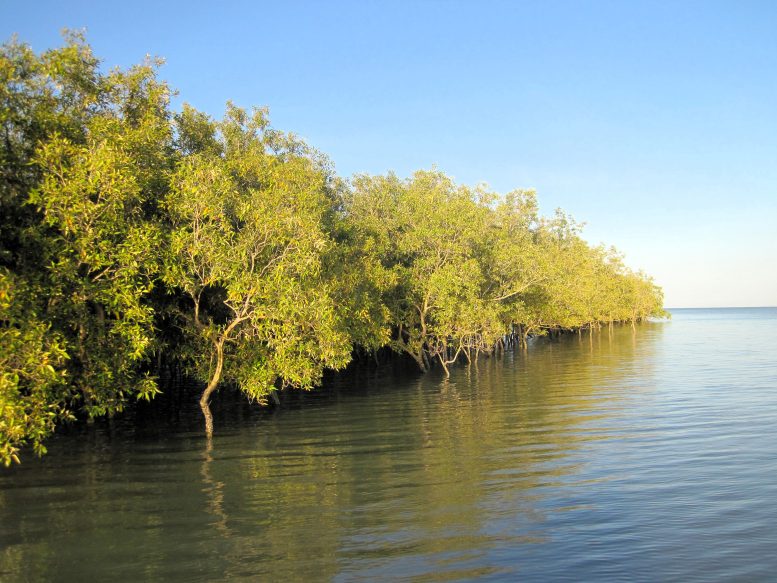
Mangroves are major carbon sinks. New research shows that the climate mitigation effect is even better than previously thought. Credit: Luke Jeffrey
Mangroves and salt marshes capture significant quantities of carbon, thereby reducing the greenhouse effect. New research from the University of Gothenburg shows that these environments are perhaps twice as effective as previously thought.
Natural habitats flooded by the tide form ecosystems that captures large amounts of carbon, which can help to mitigate climate change. Carbon dioxide is stored in the biomass and in the muddy soils. Therefore, several governments have launched blue carbon market initiatives to encourage landowners to restore and preserve mangrove and saltmarsh ecosystems, similar to the rainforest.
Large flow of bicarbonate
A new research report from the University of Gothenburg shows that the climate mitigation effect is even better than previously thought.

Gloria Reithmaier, researcher in marine chemistry at the University of Gothenburg. Credit: Michael Reithmaier
”We have uncovered additional stored carbon in mangrove forests and salt marshes. Our new findings show that much of the carbon is exported to the ocean-bound as bicarbonate as the tide recedes and remains dissolved in the ocean for thousands of years. Bicarbonate stabilizes the pH and can reduce ocean acidification. This contribution has previously been overlooked,” says Gloria Reithmaier, a researcher in marine chemistry at the University of Gothenburg.
Bicarbonate is harmless and is used in baking powder, among other things. In the oceans, carbonate and bicarbonate are used to build shells and coral skeletons.
Measured all over the world
Reithmaier and her colleagues enlisted the help of scientists from 12 different countries to analyze intertidal carbon transport in 45 mangrove swamps and 16 salt marshes around the world. When they accounted for bicarbonate export from the ecosystems to the ocean, the size of the carbon trap in these ecosystems doubled.
”Our results showed that bicarbonate exports were equal to, or even surpassed, the amount of carbon stored in the soil. Therefore, previous estimates of these blue carbon sources have underestimated the potential of mangroves and saltmarshes to mitigate climate change,” says Gloria Reithmaier, adding:
”Our results show that blue carbon ecosystems are more effective in mitigating climate change than previously thought. It is now even more important to protect and restore mangrove and salt marsh ecosystems.”
Reference: “Carbonate chemistry and carbon sequestration driven by inorganic carbon outwelling from mangroves and saltmarshes” by Gloria M. S. Reithmaier, Alex Cabral, Anirban Akhand, Matthew J. Bogard, Alberto V. Borges, Steven Bouillon, David J. Burdige, Mitchel Call, Nengwang Chen, Xiaogang Chen, Luiz C. Cotovicz Jr, Meagan J. Eagle, Erik Kristensen, Kevin D. Kroeger, Zeyang Lu, Damien T. Maher, J. Lucas Pérez-Lloréns, Raghab Ray, Pierre Taillardat, Joseph J. Tamborski, Rob C. Upstill-Goddard, Faming Wang, Zhaohui Aleck Wang, Kai Xiao, Yvonne Y. Y. Yau and Isaac R. Santos, 11 December 2023, Nature Communications.
DOI: 10.1038/s41467-023-44037-w









This article is a little disconcerting because it really speaks to how poorly we understand the Carbon Cycle. Furthermore, there was recently research published that suggests that mangrove forests could be responsible for future problems as humans and their land use changes encroach on them.
https://scitechdaily.com/mangroves-in-crisis-the-50000-carbon-time-bomb-ticking-towards-2100/
While there are many who believe that “the science is settled,” and we know everything we need to know to justify eliminating the use of fossil fuels, and investing heavily in untried alternatives, there are, clearly, debates over not only the quantitative impacts that changes in Earth Systems are likely to have, there are even uncertainties about the sign of the direction of change. Another example is, https://scitechdaily.com/nature-is-behaving-strangely-and-scientists-dont-know-why/ where the existing theories are simply wrong, apparently. This results in problems such as are exposed here: https://scitechdaily.com/planting-peril-the-unseen-risks-of-africas-reforestation-projects/ .
The hubris of thinking that we know all the problems, and their solutions, could well create more severe problems than what we think we are facing — such as geoengineering gone awry.